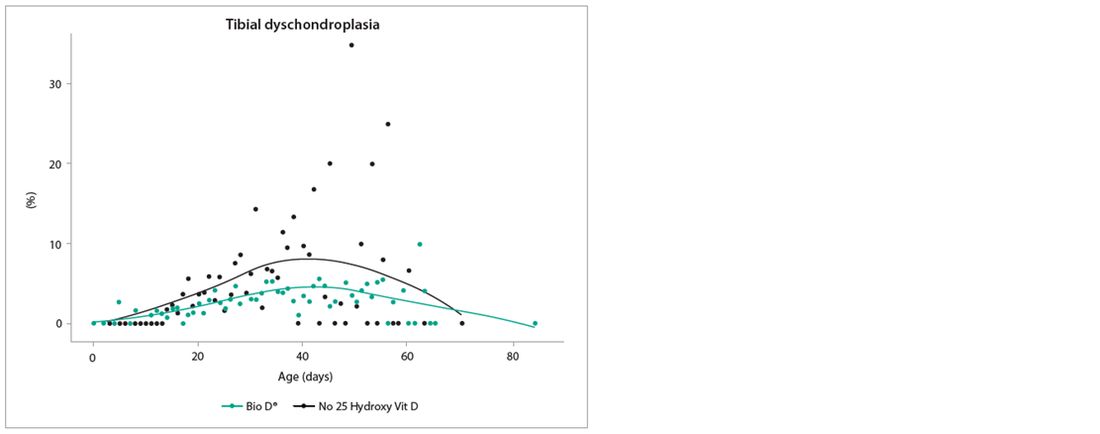The active metabolite of vitamin D, 1,25-dihydroxy vitamin D3, is considered a hormone and is involved in calcium (Ca) metabolism. It helps to regulate intestinal Ca absorption, skeletal Ca deposition and skeletal Ca reabsorption, with a link to serum Ca levels. As such, vitamin D is a major factor in supporting the formation of proper skeletal structures, whilst also playing a role in eggshell composition and meat quality (Edwards, 2000; Fleming, 2008; Garcia et al., 2013; Roberts, 2004; Saunders-Blades and Korver, 2014). The broad impact of vitamin D makes it an essential component in poultry diets for broilers, breeders and laying hens alike (Roberts, 2004; Świątkiewicz et al., 2016).
This is especially true in modern poultry production systems, as the animal's natural capacity to produce the vitamin is often hindered in commercial housing systems. Under normal circumstances, the active form of vitamin D can be produced by the animal itself, starting from a cholesterol precursor (7-dehydrocholesterol) present in the skin. However, the metabolic pathway to do so requires direct sunlight in its initial phases (UV radiation; Sakkas et al., 2018). As this direct sunlight is often restricted in commercial operations, additional dietary supplementation of vitamin D or one of its metabolites has become a necessary good standard practice in poultry diets.
There are several dietary vitamin D forms and metabolites which could be used in poultry diets, although there are noticeable differences in their bioavailability, toxicity risks and practical considerations (Biehl et al., 1998). Of the available metabolites, 25-hydroxy vitamin D3 stands out. Compared to standard vitamin D3, it does not rely on the liver for metabolism to the active form of vitamin D, whilst it has great stability and availability in animal feed. Research done by Borel et al. (2015), Świątkiewicz et al. (2016) and Fritts and Waldroup (2003) all concluded that 25-hydroxy vitamin D3 was more easily absorbed than vitamin D3, with the 25-hydroxy vitamin D3 also giving the best body weight and bone ash, resulting in fewer incidences of tibia dyschondroplasia.
Tibial dyschondroplasia (TD) can account for up to 30% of all bone diseases in poultry, and sometimes up to 10% mortality. The importance of reducing this challenge in modern poultry is clear. The above described impact of 25-hydroxy vitamin D3 on mitigating TD is in line with Huvepharma®'s internal research, conducted with Bio D®. This novel source of 25-hydroxy vitamin D3 is produced via fermentation, in contradiction with most currently available sources of the metabolite that are produced via a synthetic pathway. As a result, Bio D® can be considered as a biological alternative of the metabolite, with improved bioavailability and stability.
To evaluate how Bio D® can help to mitigate the risk of TD, a statistical analysis was carried out with the help of Aviapp®, the broiler health platform* from Huvepharma®. The information used in the analysis originated in the United States and was shared anonymously by the users of the platform, compromising 6,418 broiler flocks in total. The statistical analysis evaluated the effects of supplementing broilers with Bio D® in the first 14 days of life, versus no additional 25-hydroxy vitamin D3, on the prevalence of TD.
Flocks in the control group (1,255 flocks) were fed a standard basal diet with no additional 25-hydroxy vitamin D3 supplementation in any of the feed phases. Flocks in the Bio D® group (5,163 flocks) were also fed a standard basal diet but supplemented with Bio D® in the first 14 days of life, equal to 34 μg 25-hydroxy vitamin D3 per kg of feed. Animals from both treatment groups were evaluated for the presence of TD during standard scoring sessions, spread out over the full production cycle. Data was uploaded to Aviapp® and analysed based on odds ratios, adjusted for age of the flock as well as the supplementation of Bio D®, with a significance of P<0.05.
Based on this statistical analysis, inclusion of Bio D® during the first 14 days of life significantly reduced the TD prevalence in general, showing an overall odd ratio of 1.863 (P<0.001; Figure 1). This odds ratio indicates that compared to no 25-hydroxy vitamin D3 supplementation, adding Bio D® to the diet in the first 14 days of life translates to a significantly reduced risk of TD by almost 50%. For example, at the observed peak around 40 days of age, TD prevalence in the non-supplemented group was 8.1%, compared to only 4.5% in the Bio D® supplemented group. As TD remains an important issue in modern poultry production, this analysis showcased how Bio D® can help to manage the challenge.

The above highlights the benefit of including a vitamin D source in the feed, with both research and practical considerations pointing towards 25-hydroxy vitamin D3 as the most interesting form available. When deciding which 25-hydroxy vitamin D3 should be used, Bio D® offers a great solution, combining optimal bioavailability, stability and efficacy in one product.
*Data can be collected and uploaded to the platform, allowing users to anonymously benchmark their own operation with the respective country average, but only if they want to: users remain the owner of their data and decide what, how and if they want to share any information.


